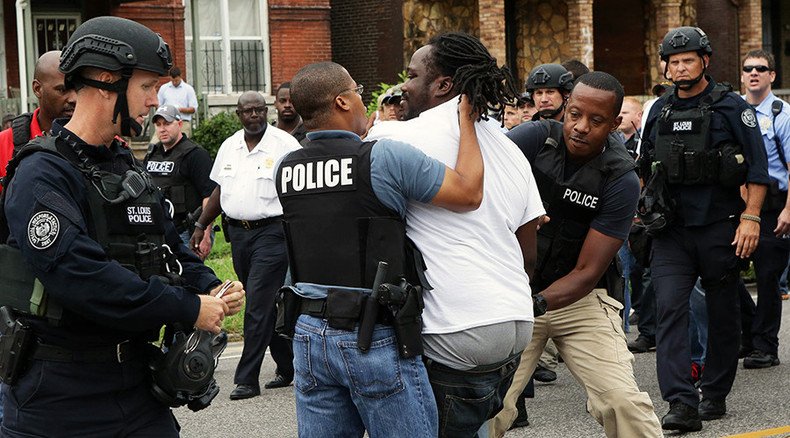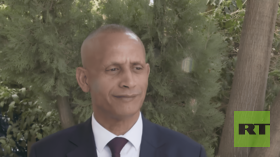DOJ reports on policing Ferguson unrest could cost taxpayers more than $1mn

The Justice Department could pay two contractors over a million dollars total to produce reports on the St. Louis County Police Department response to violence that erupted in Ferguson, Missouri last August. Yet critics contend the reports will be biased.
The DOJ hired the Police Foundation to produce a report on “collaborative reform” for the St. Louis County PD and the Institute for Intergovernmental Research for an “after-action” report on the department’s policing during the 17 days of violence and looting in the St. Louis suburb after a white Ferguson Police Department officer shot and killed an unarmed black teen on August 9, 2014.
Justice Dept. blasts Ferguson police response to protests in leaked report http://t.co/nSyIoQJGDTpic.twitter.com/RbSCaDyB2h
— RT America (@RT_America) July 1, 2015The St. Louis Post-Dispatch obtained copies of the contracts with the two outside companies via a public records request. Those contracts show that the Institute for Intergovernmental Research estimated it will cost $225,000 to complete its report, while the Police Foundation report will cost about $780,000. That collaborative reform report was initiated at the request of St. Louis County Police Chief Jon Belmar in September.
The after-action report budget includes $54,450 for contractors and $37,600 to travel to St. Louis. The collaborative reform report anticipates more than 140 days of consultant work, spread among at least a half dozen consultants, at a rate of $550 a day; travel costs; multiple trips to St. Louis by Police Foundation officials; phones; space rental; and other costs, the Post-Dispatch reported.
But former St. Louis County police chief Tim Fitch thinks the Justice Department reports will be biased against the county police department.
“They’re being paid to say whatever the DOJ wants them to say,” he told the Post-Dispatch. “It certainly is stunning that the DOJ would spend that amount of money to conduct a review of a police agency that already has the highest level of accreditation of any agency in the country.”
Fitch said that the federal government should allow police agencies to hire their own experts, so both sides of an issue could be presented to decision makers.
‘Searing’ DOJ review finds ‘distrust and hostility’ between police & Ferguson residents http://t.co/40RprYH8N9pic.twitter.com/Tdaz37rpQH
— RT (@RT_com) March 5, 2015The DOJ’s Office of Community Oriented Policing Services (COPS), which hired the two companies, defended its use of contractors to complete the reports.
COPS spokeswoman Mary Brandenberger told the Post-Dispatch that the agency hires outside contractors to produce “nonbiased, fair and objective” reports, for which there is a price.
“I’m not aware of any police analysis charities out there,” she said.
“We peer-review everything,” Brandenberger added. “It is a third-party, independent analysis.”
But the cost compared to a previous after-action report gives some credence to Fitch’s criticisms.
Oakland will pay $4.5 million to injured Occupy activist Scott Olsen http://t.co/lc4hniR4Ng
— RT America (@RT_America) March 21, 2014In December 2011, the city of Oakland, California hired the Frazier Group LLC to complete an after-action report on its police department’s response to the Occupy Oakland protests. City Administrator Deanna Santana announced the “multi-phased” investigation, which she said had a budget of $100,000, according to the Oakland North. Thomas Frazier, the president of the Maryland-based consulting group, said that he expected the investigation to take up to 90 days. He had hired three investigators with deep roots in command and police tactics to help him.
RT reached out to Frazier for a breakdown of the costs of his report, but did not receive an answer.
Fitch also complained about the DOJ’s selection of the Police Foundation as one of the contractors. He noted that the company’s president, James Bueermann, was critical of the police response in Ferguson during interviews with various media sources in August and September.
“So the Department of Justice went shopping for an independent review of the St. Louis County police and lo and behold, they find the guy who was critical of our actions just weeks after the events of last August?” Fitch said. “Why is it any surprise then that this organization stands to make over a million dollars to say the exact same thing the Foundation president was saying last year?”
UPDATE: Confirmed: #ferguson police chief resigns following DOJ report http://t.co/90KwHZAtxEpic.twitter.com/LhBFeJIgAG
— RT America (@RT_America) March 11, 2015Both the Police Foundation and the Institute for Intergovernmental Research were selected under the 2014 competitive grant solicitation for the Community Policing Development grant program, Shannon R. Long, a senior police analyst in the COPS office, told RT.
Regardless of the costs, the recommendations contained within the two reports could have long-term effects on the St. Louis County PD and other departments across the country.
“We are not just telling Ferguson what they could have done better, or the agencies in the Ferguson area,” Brandenberger told the Post-Dispatch. “We are kind of telling everybody else, too, law enforcement agencies across the country, that hopefully you will never have to deal with this situation, but if you do, these are the things that will help avoid” mistakes.
The hope is that the police department will be able to take the reports and become a model law enforcement agency as a result of the DOJ reforms. Which is exactly what happened in Oakland after it received its after-action report in 2011.
Oakland Police Chief Sean Whent and Assistant Chief Paul Figueroa have visited departments around the country in the wake of the Ferguson unrest, explaining how they were able to reform a police force with a cowboy culture reputation that had been forced to pay out millions of dollars to settle police brutality lawsuits not so long ago. Both the White House and the California Legislature have taken notice of the turnaround, and are using Oakland as an example for further reforms.
Oakland, county pay $1mn settlement over heavy-handed policing of protesters http://t.co/iXazZ9xLrQ
— RT America (@RT_America) June 25, 2013"We recognize the way we've done things in the past has not always been successful for us, so we're trying to learn from our mistakes," Whent told the Oakland Tribune at the beginning of May.
The Oakland PD has an advanced body-camera program that other forces are interested in emulating. The program began in 2010; by 2013, all uniformed officers were wearing cameras. It’s led to a steady annual decrease in use-of-force incidents ‒ 611 in 2014, down from more than 2,000 each in 2008 and 2009 ‒ and citizen complaints ‒ down to 1,052 after nearly 2,600 during the height of the Occupy Oakland protests in 2012. The department also hasn’t had a fatal officer-involved shooting since 2013.
Body cameras reduce police use-of-force, citizen complaints - study http://t.co/2MuzDnaAIQpic.twitter.com/3ZkmCE9Sln
— RT America (@RT_America) December 24, 2014The department is also working with Stanford University to analyze data on police stops, including footage from body and dashboard cameras.
Like it will be in St. Louis County, Oakland’s turnaround wasn’t by choice. It was required under a federal monitoring agreement signed in 2003.
“I don't want to deny anyone the credit they deserve, but remember that whatever progress has been made happened with a gun pointed at their head," police critic Rashidah Grinage told the Oakland Tribune. "It's not like they woke up and said, 'Why don't we start looking at our stop data today?' "













